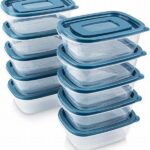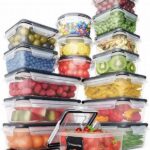Imagine waking up late for work, rushing through your morning routine, and realizing you still have to prepare lunch. We’ve all been there! That’s where the magic of microwave-safe food containers steps in like a superhero to save the day. These not-so-ordinary containers are pivotal in our daily lives, ensuring that our food is reheated safely and efficiently, without the risks and mess. But with so many options flooding the market, how can you be sure that the container you’re using won’t transform your microwave into a mini firework show or, even worse, leach harmful chemicals into your food?
Read More : Sea Containers Converted Into Modern Desert Vacation Houses
Let’s dive into the world of microwave-safe food containers, a land where convenience meets safety. Whether you’re a busy parent trying to pack lunches or someone just trying to reheat last night’s takeout, this guide is your ticket to hassle-free microwaving. From understanding the types of materials considered safe to discerning features that keep your food warm and your body safe, our microwave container manifesto will have you mastering the art and science of microwave cooking in no time.
Understanding the Need for Microwave-Safe Containers
When it comes to daily microwave usage, not all food containers are created equal. Selecting the right one can be a game-changer, not just for preserving food quality, but for ensuring your health and safety. Containers made of glass, certain plastics, and ceramics often top the list. What sets them apart are their ability to withstand the heat without compromising the food inside them.
Why Material Matters
Glass and ceramic containers are generally the champion picks since they are inorganic and do not leach chemicals. However, not every glass or ceramic container is microwave-safe. That’s where labels and symbols come into play. For plastics, it’s crucial to ensure that they are BPA-free and marked as microwave-safe by the manufacturer. We can’t emphasize enough: Always read the packaging to avoid any unwanted kitchen disasters!
The Science Behind Microwave Safety
How Microwaves Interact with Containers
Here’s the secret: not every container material interacts with microwaves the same way. Microwaves cause the water molecules in food to vibrate, producing heat. When the material of your container is transparent to microwaves, like glass, it doesn’t interfere with this process. Plastic containers, if not microwave-safe, can melt and warp, potentially leaching harmful substances like BPA into your food. Trust us, you don’t want an unwanted side of chemicals with your spaghetti!
Factors to Consider When Choosing Containers
When buying food containers safe for microwave oven daily usage, consider factors like durability, ease of cleaning, and sealing effectiveness. A tight lid provides more than just a good seal; it prevents splatters which means less cleaning up. And who doesn’t love less cleaning?
Best Practices for Using Microwave-Safe Containers
Avoiding Microwave Mishaps
1. Check the Label: Always ensure that your containers are marked microwave-safe.
2. Use a Lid: But leave it slightly open to allow steam to escape.
Read More : Rust-resistant Waste Containers
3. Avoid Heating Empty Containers: They can explode or break.
4. Stir Your Food: To distribute heat evenly and avoid hot-spots.
Cleaner and Safer Usage
Did you know that regular maintenance of your containers contributes to safety as well? Follow these tips for longevity:
Detailed Guide and Purpose of Microwave-Safe Containers
Understanding microwave-safe containers involves more than just using them daily.
Materials and Features
Advantages
Common Mistakes with Containers
Key Points About Microwave-Safe Containers
Expert Tips for Effective Use
Conclusion
Microwave-safe containers are a staple in modern kitchens, transforming how we approach meal prep and leftovers. Their utility proves indispensable, marked by their unmatched combination of convenience, safety, and efficiency. Through informed choices, we can ensure that these powerful kitchen allies serve us well without compromising health or fun. Remember, choosing the right materials can make all the difference between a perfectly heated meal and a kitchen disaster. So, gear up, check those labels, and embrace the art of microwave cooking with confidence and gusto. Let’s get rewriting those recipes, because like every food journey, it starts with the right container!










